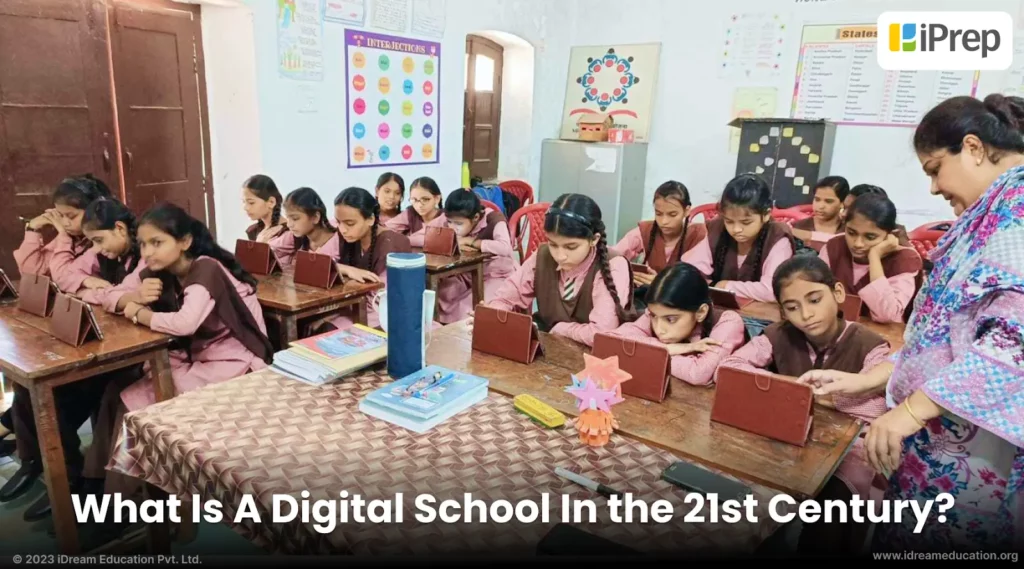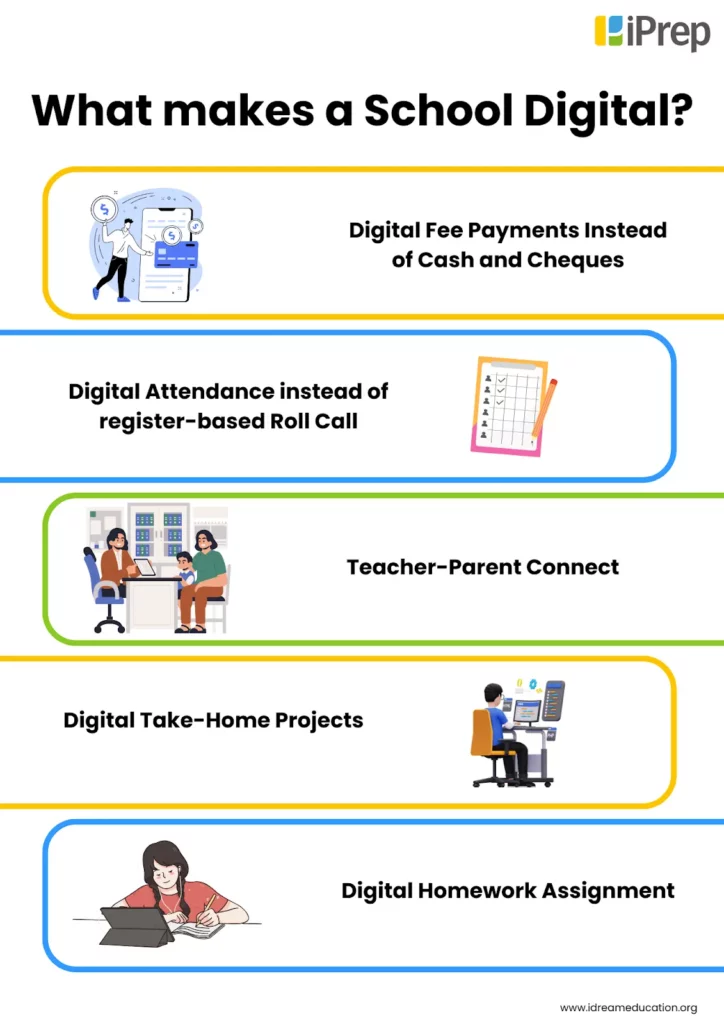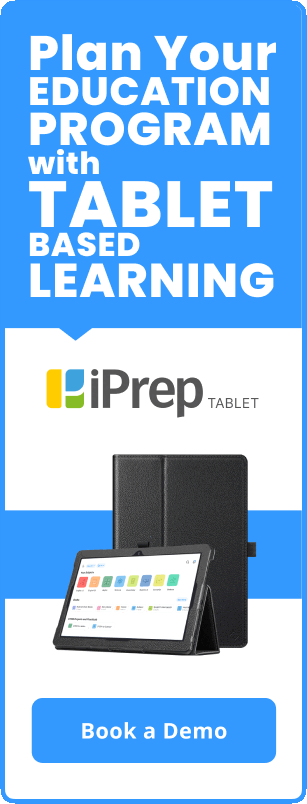What Is A Digital School In the 21st Century?

As the 21st century continues to unfold, the face of education is undergoing a profound transformation. Traditional schools, with their chalkboards and textbooks, are gradually giving way to a new era of learning—digital schools. In this blog post, we embark on an illuminating journey to unravel the essence of a digital school in the modern age.
We’ll dive into the pivotal elements that differentiate a digital school from its conventional predecessors, from the transition in general and administrative practices such as digital fee payments to the innovations in educational practices such as interactive learning experiences. Moreover, we’ll shed light on the instrumental role that comprehensive learning platforms like iPrep play in this exciting educational evolution, where technology and learning intertwine to shape the future of education.
What makes a School Digital?
The school should undergo a transition to become a digital school, complementing traditional school-related practices with digital. This involves a combination of both general and administrative Practices and Educational Practices becoming digital. Let’s start by understanding how the transition of General and administrative practices makes a digital school.
General & Administrative Practices for a Transition towards Becoming a Digital School.

1. Digital Fee Payments Instead of Cash and Cheques
To make a transition to becoming a digital school institutions are encouraged to transition towards digital fee payment methods as opposed to relying on conventional cash and cheque transactions. This shift promises to yield numerous benefits, chief among them being a substantial reduction in paperwork. By embracing digital payment systems, schools stand to significantly curtail the costs associated with manual documentation processes. Additionally, this modern approach facilitates a smoother administrative experience, alleviating burdens on staff members.
Notably, the adoption of digital payment methods translates to substantial time savings for all stakeholders involved, including administration personnel, parents, and students. Schools should employ a reputable digital payment gateway to ensure the utmost security in these transactions. It is worth highlighting that digital payments, as opposed to traditional payment methods like cheque transactions, typically require only a matter of minutes for processing, further emphasizing the expediency and efficiency of this approach.
Schools should adopt this as the first practice to transition towards becoming a digital school.
2. Digital Attendance instead of Register-based Roll Call
Educational institutions should recommend transitioning to employing digital attendance methods, such as biometric recognition and ID card scanning, rather than relying on traditional manual roll calls. When students use biometric or ID card scanning for attendance, the system should automatically dispatch a message to notify parents of their child’s arrival at school. This initiative serves to diminish absenteeism and optimize instructional time by eliminating the need for teachers to manually record attendance in class. Moreover, the adoption of digital attendance systems contributes to environmental conservation by reducing paper consumption. Additionally, it is anticipated that the implementation of digital attendance will mitigate attendance-related issues, as students are entrusted with the responsibility of recording their attendance. If this attendance approach is adopted then a normal school can easily become a digital school without any hindrances.
3. Digital Homework Assignment
Teachers should start disseminating homework and assignments digitally, as opposed to conventional paper-based methods. This shift will yield several advantages, including time-saving benefits for teachers. Digital assignments allow instructors to review and assess student work remotely or at their convenience, rather than during class hours, thereby optimizing instructional time. Furthermore, this approach offers cost-effectiveness by reducing paper consumption, as printed assignments are often discarded after grading. By embracing digital homework and assignments, the educational community can contribute to paper conservation efforts.
With applications such as iPrep Coach, Teachers can efficiently onboard all students within their designated batch. Additionally, teachers are empowered to establish batches and subsequently control their students, providing them access to tailored learning content aligned with their curriculum. Moreover, the iPrep Coach app offers a comprehensive reporting feature, enabling teachers to maintain a detailed record of student progress and performance. This functionality enhances the educational experience by facilitating organised and data-driven instruction. With the help of apps like iPrep coach a school can easily become a digital school or we can say that by adopting the practice of distributing homework assignments, a school can transition towards becoming a digital school.
4. Digital Take-Home Projects
In these projects, students are asked to use digital tools and resources to complete assignments outside the classroom, making it a modern approach to academic assignments for creating a digital school. By leveraging digital technology students have the opportunity to engage with materials interactively, fostering creativity, critical thinking, and digital literacy skills.
Students have the option to submit their projects in advance to facilitate timely assessment and feedback from teachers, providing them an opportunity to make necessary amendments before final submission. From our perspective, the digital dissemination of projects offers an added advantage as it permits students to enjoy their vacations, as they have access to the requisite technology to complete their assignments.
Digital take-home projects are a necessity if a school wishes to transition towards becoming a digital school.
5. Teacher-Parent Connect
Another significant aspect that undergoes a transition when a school becomes a digital school is the Teacher-Parent connection. Facilitating a robust teacher-parent connection within educational institutions holds significant importance, affording parents valuable insights into their child’s scholastic progress. This interaction serves as a channel for Teachers to furnish constructive feedback to parents regarding their child’s performance in school. While conventional parent-teacher meetings certainly hold merit, a digital platform for this connection proves notably more effective.
Unlike periodic parent-teacher meetings, a digital meeting permits parents and teachers to engage every week, ensuring a more continuous and dynamic exchange of information. This proposed approach represents a commendable method for effecting enhancements toward the establishment of a digital school.
Furthermore, it is possible that traditional methods, such as requesting parental signatures on students’ diaries to acknowledge feedback, may occasionally encounter issues of authenticity. Haven’t we had that friend in our class who used to copy his/her mother’s or father’s signature on the report card just to avoid getting a scolding from them?
In this regard, a digital platform not only streamlines communication but also offers a more secure and verifiable means of parental engagement. This way of communicating being a part of a digital school can make the teamwork between teachers and parents stronger. It helps everyone work together better to support a child’s learning.
Now that we have discussed general and administrative practices for transitioning towards becoming a Digital School, let’s focus on education-focused practices that help in the transition from a traditional school to a new-age digital school.
Education Focused Practices
1. Teaching
For a school to truly embrace the digital age and become a “digital school,” it is essential that the teaching aspect evolves in tandem with technological developments. This transformation goes beyond the simple incorporation of digital tools; it requires a fundamental shift in how Teachers impart knowledge and interact with students. Teachers must adopt innovative strategies, interactive platforms, and the dynamic potential of technology to implement digital teaching methodologies in the context of a digital school.
Teachers can create a more immersive and engaging learning environment by incorporating solutions such as smart classrooms, learning tablets, tablet-based digital libraries, and learning apps. This transition enables students to explore, interact, and absorb knowledge in previously unimaginable ways, fostering a tech-savvy and holistic approach to education that prepares them for the challenges of the twenty-first century.
Furthermore, such digitalization empowers Teachers with the capability to monitor and evaluate their instructional progress, including the range of topics covered during each instructional session. This technological advancement mirrors the innovative approach exemplified by the iPrep platform. Through its provision of captivating animated video lessons, proficiency-building multiple-choice question practices, and comprehensive study materials, iPrep offers a dynamic and interactive mode of learning.
Additionally, iPrep extends its educational resources to encompass supplementary content, allowing students to engage in enriching activities during their unallocated time in school. These activities serve to foster holistic development, thereby contributing to a well-rounded educational experience. If these digital methods of teaching are adopted, the transition to a digital school will be facilitated.
2. Learning
To transform a school into a digital school, the student’s educational experience must evolve into the digital realm. This transition does not necessitate the creation of virtual schools, but rather the incorporation of digital teaching and learning solutions into traditional educational settings. By implementing innovative tools such as smart classes, learning tablets, tablet-based digital libraries, and educational apps, schools can harness the power of technology to enhance the learning process and gradually transition towards becoming a digital school.
Similar to the solutions provided by iDream Education, these digital resources make education more engaging, interactive, and accessible, fostering a dynamic and contemporary educational environment. By incorporating digital elements into the learning process, schools can prepare students for the challenges of the digital age while simultaneously transforming education into an engaging and enriching journey.
3. Progress Reporting
The transformation of a traditional school into a true digital school in the digital age extends beyond teaching and learning alone. In addition to innovative tools such as smart classes, learning tablets, tablet-based digital libraries, and educational apps, the transition to a fully digital school must include the crucial aspect of progress reporting.
Adopting digital progress reporting systems empowers educators, students, and parents with real-time insights and data-driven feedback, allowing schools to efficiently track and communicate student performance. This seamless integration of digital solutions fosters a comprehensive educational ecosystem where the entire educational journey is interconnected seamlessly, enabling improved communication, personalized learning, and, ultimately, advancing students overall.
Some digital learning solutions like the ones offered by iDream Education can come as a great helping hand in this case. Each of our solutions is powered by our one-stop learning platform “iPrep” which comes with real-time progress tracking where the app, at every moment records the usage of the content present on the platform with utmost detail, and the same is presented in the form of reports in the My Reports section which is present within the app. Our Central Reporting Dashboard allows access to the same reports for one or multiple schools. Access can be shared with Heads of Departments (HODs), Principals, School Authorities, School Funders, Government authorities, and other stakeholders as per their requirements.
4. The use of learning management systems
The use of Learning Management Systems (LMS) in an Indian school has been instrumental in transforming a traditional educational institution into a digital school. LMS platforms enable schools to seamlessly transition from conventional classroom teaching to online and blended learning, providing students and teachers with a centralized platform for communication, collaboration, and content delivery. With the advent of LMS, schools can offer a wide range of courses and resources, fostering personalized learning experiences and enhancing overall educational quality.
Moreover, iPrep, an innovative educational technology provider, has been at the forefront of facilitating this digital shift. By integrating its wide library of digital learning content and real-time reporting with LMS platforms through API integration, iPrep has been able to offer a one-stop and vastly comprehensive solution for schools. The company has already successfully collaborated with multiple service providers, such as “Teachmint,” further enhancing the capabilities and effectiveness of LMS in Indian schools.
Conclusion
Transitioning all operational processes into a digital format is a foremost requirement for a school to achieve the status of being a digital school. This includes the transitions in the general and administrative practices such as digital payment methods for fees, replacing traditional cash and cheque transactions, the digitization of attendance records and homework assignments, as well as the incorporation of digital platforms for take-home projects. Moreover, fundamental educational practices such as teaching, learning, and progress reporting must also undergo digital transformation to qualify as a digital school.
In this context, learning platforms such as iPrep emerge as instrumental tools in facilitating the transition to a digital school. iPrep offers a comprehensive suite of digital resources, and a dedicated application for personalized, adaptive learning. Notably, iPrep also integrates a feature known as Personalized Adaptive Learning (PAL), further augmenting its capacity to cater to individualized learning needs.







